Unveiling the Horrors of Yesteryear: Why Eerie #3 (1951) Remains a Golden Age Icon
Dive into the chilling world of Eerie #3 (1951), a legendary Pre-Code Horror comic. Explore its iconic cover art (possibly by Wally Wood) and the bold, unsettling tales that solidified its place as a Golden Age masterpiece.
Punch Prints
7/5/20254 min read
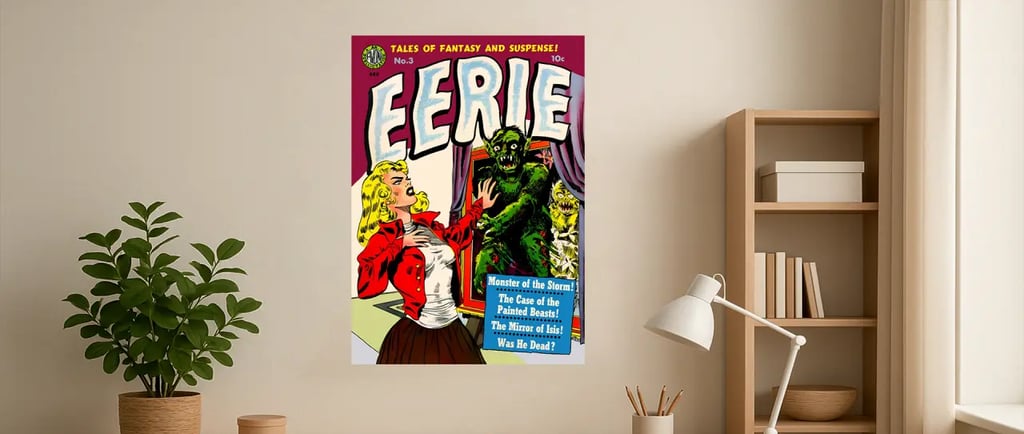

Why Eerie #3 (1951) Remains a Golden Age Icon
Step back into a time when comic book pages were raw, untamed, and genuinely unsettling. Before the strictures of the Comics Code Authority, a wave of audacious horror comics captivated and terrified readers. Among the most striking relics from this audacious era is Eerie #3, published by Avon Comics in 1951. More than just a vintage issue, this comic stands as a chilling testament to the bold creativity of the Golden Age of comics, its unforgettable cover art alone solidifying its place in history.
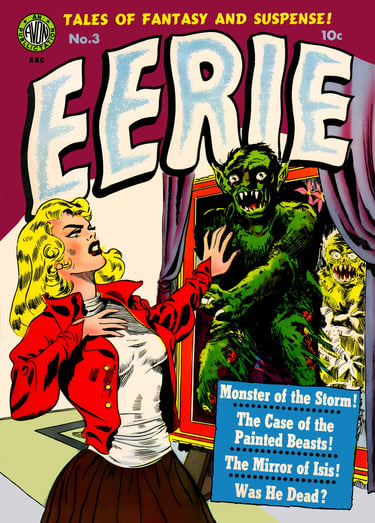

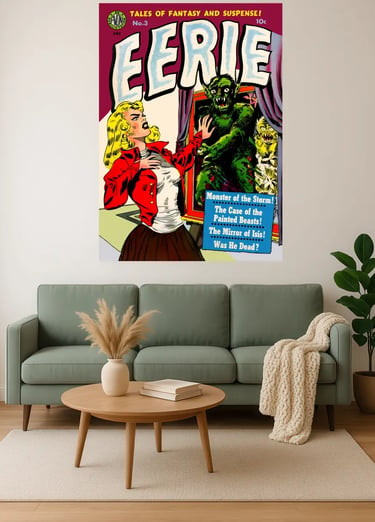

The Mirror of Madness: An Iconic Cover That Defined Pre-Code Horror
From the moment one gazes upon Eerie #3's cover, the power of Pre-Code Horror becomes undeniably clear. A truly iconic image, it depicts a monstrous, ghoulish green fiend, eyes blazing with malevolent intent, seemingly leaping forth from a cracked mirror. Its gnarled claws reach desperately towards a startled, screaming woman, her expression a perfect blend of terror and classic comic book dramatics. The tension is palpable, the threat immediate.
This cover, often attributed to the legendary Wally Wood (though uncredited), is a masterclass in suspenseful illustration. Its dynamic composition, vibrant yet unsettling color palette, and the sheer visceral horror it conveys immediately captivated readers in 1951. It wasn't just art; it was a promise of the spine-chilling tales lurking within. This singular image perfectly encapsulates the daring and often shocking nature of comics before self-censorship drastically altered the landscape of the industry, making it one of the Golden Age’s most striking and collectible images.
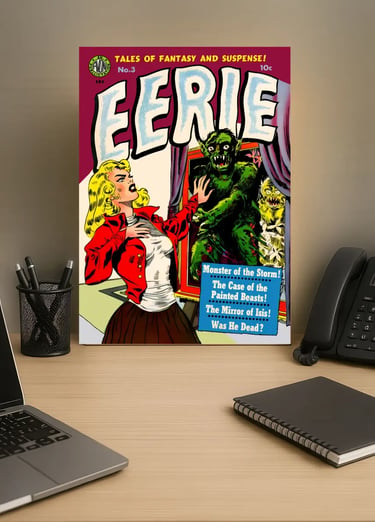



Tales of Fantasy and Suspense: Delving into the Stories Within
Beyond its legendary cover, Eerie #3 delivered on its promise of "Tales of Fantasy and Suspense!" Within its pages, readers were plunged into a world where the supernatural was commonplace and dread lurked around every corner. This issue showcased the creative freedom prevalent in the early 1950s, allowing creators to explore themes and scenarios that would soon become taboo.
The contents of Eerie #3 were as varied as they were chilling, featuring narratives that pushed the boundaries of what was acceptable in popular media at the time. Readers encountered stories such as:
“Monster of the Storm!”: A classic tale hinting at creature features and the terrors unleashed by nature.
“The Case of the Painted Beasts!”: Suggesting a mystery intertwined with monstrous transformations or illusions.
“The Mirror of Isis!”: Likely playing on ancient curses and reflections that reveal more than meets the eye, directly tying into the cover's theme.
“Was He Dead?”: A suspenseful query promising a twist of fate or an exploration of the undead.
These bold stories, characteristic of the era, reveled in the grotesque, the mysterious, and the genuinely frightening, providing a direct, unfiltered dose of horror to eager audiences.


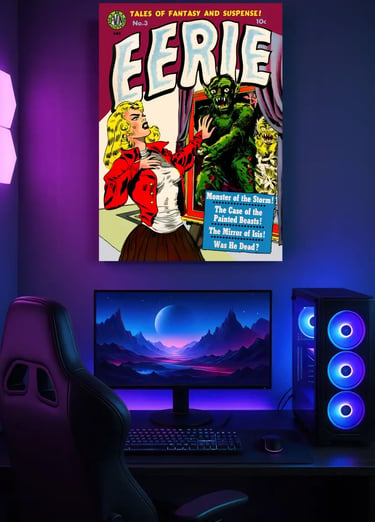

Avon Comics: A Pioneer in the Golden Age of Fear
Published by Avon Comics in 1951, Eerie #3 belongs to a pivotal moment in comic book history known as the Golden Age (roughly 1938-1955). While many associate this period with the rise of superheroes, it was also a fertile ground for a diverse array of genres, including crime, romance, and crucially, horror. Avon was one of several publishers that embraced the burgeoning popularity of horror comics, pushing the envelope with macabre themes and explicit artwork.
The "Pre-Code" designation is vital here. It refers to the period before 1954, when public outcry and government scrutiny led to the establishment of the Comics Code Authority. This self-regulatory body imposed strict rules on comic content, effectively sanitizing horror comics and leading to their near disappearance. Eerie #3, therefore, serves as a significant artifact from a brief, unbridled era when comic creators had the liberty to explore darker, more mature themes without censorship.
A Legacy That Haunts: Why Eerie #3 Endures
Today, Eerie #3 is not merely a collector's item; it's a historical document that offers a window into the evolution of horror media and censorship. Its importance lies in:
Historical Significance: It represents the peak of uninhibited horror comics before the Code dramatically altered the industry.
Artistic Merit: The strength of its cover art, possibly by Wally Wood, showcases the high caliber of talent working in comics during this period.
Cultural Impact: It played a part in the societal conversations around media's influence on youth, which ultimately led to the Comics Code.
Enduring Appeal: Its classic horror tropes and unsettling visuals continue to captivate enthusiasts of vintage comics and horror history
Eerie #3 stands as a powerful reminder of a bygone era in comic book publishing – a time when imagination, suspense, and a healthy dose of the macabre reigned supreme, leaving a legacy that still sends shivers down the spine. It's a must-see for anyone interested in the raw, uncensored artistry that defined the Golden Age of comic book horror.
